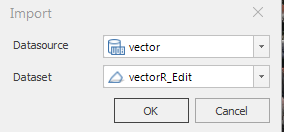Oblique photogrammetric data clipping
Instructions for use
The oblique photogrammetric data clipping function enables custom clipping of OSGB data, which can be achieved by selecting or drawing a polygon as the clipping area.
This method allows users to obtain OSGB data within specific ranges as needed.
Function Entry
- 3D Geodesign tab->OSGB Data operation->Clip button
- Toolbox->3D Data->Oblique data computation->Oblique data clipping
Operating Steps
- Create a new global scene. Right-click "Scene" in the Workspace Manager and select "New Global Scene".
- Load 3D Tiles. Select the normal layer in the Layer Manager, right-click and choose "Add Model Tile Layer", or in the "Scene" tab's "Data" group, click the "Tile" drop-down button, and select "Load Tiles..." from the drop-down menu. For specific operations, refer to help Load Tile.
- Select the 3D Tiles file layer in the Layer Manager, right-click "Jump to Layer", and in the scene, hold the mouse wheel to adjust the camera to a view suitable for clipping the model.
- In the 3D Geodesign tab's Oblique Photography Data Operation group, click the Clip button to open the "Oblique photogrammetric data clipping" panel.
- Layer selection: Click the drop-down arrow in the combo box next to "Oblique photography data layer" to select the clipping target layer.
- Clipping polygon definition: Provides two methods: "Select Polygon" and "Draw Polygon".
- When clicking "Select Polygon", select a polygon object in the scene to define the clipping polygon. To select multiple polygons for the operation, hold the Shift key while selecting in the scene.
- When clicking "Draw Polygon", use tools like "Rectangle", "Polygon", and "Import" from the toolbar to define the clipping polygon. Click the "Rectangle" or "Polygon" tool, and the mouse cursor will display a red dot. Click to start drawing the region, and right-click to finish, completing the clipping polygon definition. Click the "Import" tool to open the import dialog, select a region dataset as the clipping area, as shown below.

Figure: "Import" dialog
- Export clipping polygon: Supports exporting the drawn clipping polygon by clicking the "Export" button.
- Clipping parameters:
- Clip mode: Choose "Reserved Area" or "Outside Reserved Area" clip mode. "Reserved Area" clip mode retains OSGB data inside the clipping area, while "Outside Reserved Area" clip mode retains OSGB data outside the clipping area.
- Clip boundary elevation: Select the constraint method as "Keep with Source Data" or "Keep with Clip Polygon". "Keep with Source Data" maintains the original elevation values at the boundary, while "Keep with Clip Polygon" aligns the boundary elevation with the clipping polygon's elevation values.
- By default, the "Preview" checkbox is selected, enabling real-time preview of the clipping result.
- Result data save settings:
- Click the file open icon next to "Path" to select the storage path for the clipping result, or directly enter the storage path in the text box.
- Enter the filename for the result storage in the text box next to "Target Name".
- Click "Save" to save the oblique photogrammetric data clipping result. An example of the result using polygon clipping is as follows:

Figure: Clipping effect diagram
 Notes:
Notes:- When setting clip boundary elevation to "Keep with Source Data", the Z-value of the clipping polygon does not take effect.
- When drawing the clipping area, ensure the scene is viewed from above to guarantee drawing point accuracy.



